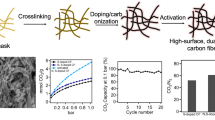Abstract
The storage of large quantities of CO2 in a chemically-bonded framework is a key factor in establishing an energy efficient and environmentally sound society. The solvent scrubbing process provides an economically feasible way to capture CO2 industrially. However, it suffers from inherent problems such as corrosion/leakage problems, difficulty with the regeneration process, and potential environmental issues. In this regard, the solid adsorbent is deemed as a next-generation carbon-capture platform. However, most reported materials involve complex and expensive synthesis processes, hampering their practical use in the field. Inspired by the concept of solid-supported amines and by the reversible sorption of CO2 in amine solutions, in this paper, we assess the CO2 sorption performance of raw diamine solid molecule of p-phenylenediamine (pPD), which could be coupled with construction materials to meet the design construction standards for sustainable buildings. CO2 sorption induced structural transformation of pPD and morphology-change induced enhancement of CO2 sorption kinetics are presented.
Similar content being viewed by others
References
J. C. Abanades, E. S. Rubin and E. J. Anthony, Ind. Eng. Chem. Res., 43, 3462 (2004).
B. Wang, A. P. Côté, H. Furukawa M. O’Keeffe and O. M. Yaghi, Nature, 453, 207 (2008).
H. Furukawa and O. M. Yaghi, J. Am. Chem. Soc., 131, 8875 (2009).
M. B. Yue, Y. Chun, Y. Cao, X. Dong and J. H. Zhu, Adv. Funct. Mater., 16, 1717 (2006).
C. Chen, S. T. Yang, W. S. Ahn and R. Ryoo, Chem. Commun., 24, 3627 (2009).
Y. Lee, D. Liu, D. Seoung, Z. Liu, C. Kao and T. Vogt, J. Am. Chem. Soc., 133, 1674 (2011).
A. Wahby, J. M. Ramos-Fernández, M. Martínez-Escandell, A. Sepúlveda-Escribano, J. Silvestre-Albero and F. Rodríguez-Reinoso, ChemSusChem, 3, 974 (2010).
G. P. Hao, W. C. Li, D. Qian, G. H. Wang, W. P. Zhang, T. Zhang, A. Q. Wang, F. Schüth, H. J. Bongard and A. H. Lu, J. Am. Chem. Soc., 133, 11378 (2011).
V. Presser, J. McDonough, S. H. Yeon and Y. Gogotsi, Energy Environ. Sci., 4, 3059 (2011).
K. Sumida, D. L. Rogow, J. A. Mason, T. M. McDonald, E. D. Bloch, Z. R. Herm, T. H. Bae and J. R. Long, Chem. Rev., 112, 724 (2012).
T. Wang, H. Huang, X. T. Hu, M. X. Fang, Z. Y. Luo and R. N. Guo, Chem. Eng. J., 323, 320 (2017).
C. Shi and Y. Wu, Resour. Conserv. Recyd., 52, 1087 (2008).
A. Grondein and D. Bélanger, Fuel, 90, 2684 (2011).
V. M. Suresh, S. Bonakala, H. S. Atreya, S. Balasubramanian and T. K. Maji, Acs Appl. Mater. Inter., 6, 4630 (2014).
M. Colapietro, A. Domenciano, G. Portalone, G. Schultz and I. Hargittai, J. Phys. Chem., 91, 1728 (1987).
H. Kang, D. Y. Koh, Y. H. Ahn, S. Jung, J. Park, J. Lee and H. Lee, J. Chem. Eng. Data, 60, 238 (2015).
A. Czapik, H. Konowalska and M. Gdaniec, Acta Cryst., C66, 128 (2010).
S. Moon, Y. H. Ahn, H. Kim, S. Hong, D. Y. Koh and Y. Park, Chem. Eng. J., 330, 890 (2017).
Acknowledgements
This work was supported by the National Research Foundation of Korea(NRF) grant funded by the Korea government (MSIT) (No. 2021R1C1C1012014, 2021R1F1A1047108). It was also supported by Basic Science Research Program through the National Research Foundation of Korea (NRF) funded by the Ministry of Education (No. 2020R1G1A1102678).
Author information
Authors and Affiliations
Corresponding authors
Additional information
Financial Disclosure
Authors have no relevant financial interests in this manuscript.
Rights and permissions
About this article
Cite this article
Lee, S., Ahn, YH. & Koh, DY. Sustainable building materials employing solid diamines as CO2 sorbents. Korean J. Chem. Eng. 39, 1975–1980 (2022). https://doi.org/10.1007/s11814-022-1061-z
Received:
Revised:
Accepted:
Published:
Issue Date:
DOI: https://doi.org/10.1007/s11814-022-1061-z




